Multi-Line Phone Systems for Small Business
If your small business is growing, you might have experienced an uptick in calls. This is positive news for any business owner, but it can also become overwhelming if you aren’t using the right small-business phone system. If you leave customers on hold too long or their calls don’t go through, they may get upset and take their business elsewhere. Lost sales can stop the progress your business has made. That’s why finding the best business phone systems for your small business is so important. You might be wondering, What should I look for in a business phone system? We’ve created this guide to spotlight a potential solution called multi-line phone systems. We’ll explain what they are and what features to look for when choosing one. Let’s dive in.

What Is a Multi-Line Phone System?
A multi-line phone system is one that allows you to handle multiple calls at once. It does more than let several of your employees make or receive calls at the same time. It also lets your employees answer calls, put someone on hold, and make another call either internally or externally all at once. You can choose a phone system that has two lines, three or four lines, or five lines and above.
When deciding how many lines you need, consider how many people will need to make and receive calls. If it will only be you and one or two other employees who will make calls occasionally, two lines should be enough. If you have a few employees who will all need access to a phone line at some point, a three- or four-line phone system for your small business might be more ideal. And if you want all of your employees to have their own phone line, or your business receives a lot of calls, having five or more lines might work best.
When it comes to multi-line phone systems, there are three different kinds for you to choose from. They are key service utility systems (KSU), private branch exchange (PBX), and voice over internet protocol (VoIP).
- KSUs are the oldest version and require you to connect a set number of lines to central hardware.
- PBX, slightly newer than KSUs, allows employees to use handsets at their desks to make and receive calls.
- VoIP, which many PBX systems now work through, gives businesses a better multi-line phone system experience by allowing you to make and receive calls from VoIP on any device with an internet connection, like tablets, laptops, and cell phones (this is called a “softphone” system — in this case, soft equals software). VoIP comes with the most features and allows for the most flexibility of all the multi-line phone systems, since you can use any device with it.
How Do I Add a Second Phone Line to My Business?
If you want to add a second phone line to your business, you have two options: to use a line splitter or to use a multi-line phone system. As the name suggests, a line splitter physically splits a phone line in two so that you have access to a second phone line. You will need another phone or device to connect to it to make it work. To use a line splitter, you plug it into a two-line wall jack and then plug your devices into the splitter.
Multi-line phone systems, on the other hand, often require you to use some sort of physical platform. With the platform in place, you can have multiple phone lines connected to a single device. And, if you need more than two lines on it down the road, you can easily add more. You will just have to call your provider to set it up for you.
With unified communications, and VoIP in particular, adding a new “line” is as easy as installing an app on another device that can connect to the internet. You’ll need a username to make and receive calls — the username is considered the “line” in VoIP. And most unified communications providers allow you to manage your lines easily through your online account.
How Do I Manage Multiple Phone Lines?
The concept of having multiple phone lines seems great. You can handle more calls and keep your customers satisfied. However, how do you actually answer multiple phone lines? After all, you’re only one person. The following features can help you or any other team member better manage several phone lines at once:
- Call Announce: Learn who’s calling and why before a team member answers. This will help you decide whether to answer the call right away, transfer it, or send it to voicemail.
- Call Hold: Keep customers on the phone as you switch from one call to another. You can do this with one click of a button. Call hold is also helpful when finding information for a customer.
- Call Park: Instead of transferring a call directly to another team member, transfer a call to an extension accessible to several people on your team, so that whoever is available next can answer it.
- Call Waiting: Your phone will let you know that you’re receiving another call even if you are already on the phone. This feature will let you decide whether to send the incoming call to another team member, put the incoming call on hold, or send it to voicemail.
- Caller ID: See who’s calling even before you pick up the phone so you can better decide whether to answer.
- On Demand Call Recording: Record phone calls so that you can listen to them again later or send them to team members as necessary. This feature works well for taking notes, getting feedback from supervisors, or training new employees.
- Virtual Assistant: Use conversational AI for voice-enabled customer self-service when you experience high volumes of calls and/or have customers who need quick answers.
- Virtual Receptionist: Set up rules to route calls to the right department so that you don’t have to hire another person to do it manually.
In addition to these features, you should consider implementing some best practices to make managing multiple phone lines easier. For one, you can either hire a receptionist or use a receptionist console. Doing so can reduce customer hold times by directing the customer to the appropriate department or employee instead of making them wait in a long line with every other caller.
You’ll also want to ensure that employees have the necessary equipment and space for effective call management. For example, adding cubicles to your office space or spreading out desks will give in-office employees the quiet they need to hear and speak to callers while increasing privacy on calls in case of sensitive discussions. For employees who work from home, your business could consider offering a tech allocation to cover costs for the WiFi and equipment they’ll need to make calls from home.
Providing employees with earpieces and headsets can also free up their hands to more effectively take notes or search for the appropriate information for customers. Plus, because UCaaS and VoIP only requires an internet connection, you won’t need that “closet full of wires” found in legacy phone systems.
What Is the Main Advantage of Using a Multi-Line Telephone System?
When it comes down to it, the main advantage of using a multi-line telephone system is that you can easily receive and transfer calls to the appropriate team member so that customers get their questions answered quickly and sufficiently. And a virtual phone receptionist can give callers a list of options and prompts to select from based on a preconfigured menu you’ve set. This menu can change based on holidays, business hours, and other schedules. Based on how callers respond to the prompts, the virtual receptionist routes calls to the correct team or employee.
Other advantages of multi-line phone systems for small business include:
- Money Savings: Aside from the initial investment of buying new equipment for employees, if necessary, multi-line phone systems tend to save businesses money. That’s because with VoIP, your calls will take place online — you won’t have the related expenses of adding on physical phone lines.
- Flexibility: Multi-line phone systems allow you to easily add or remove phone lines as needed. For VoIP or UCaaS systems in particular, all you will need is an internet connection. These are typically easy to install and you can do it yourself.
- Feature Options: No matter what your business looks like or how big it is, you can customize your system to fit your needs. We cover specific features you can use later.
- Reliability: Because VoIP systems are usually cloud-based, your data will have an additional layer of protection. On top of that, multi-line phone systems can block spam calls so that your business is only receiving important calls. And a technology like SD-WAN can optimize bandwidth across networks, allowing users to prioritize traffic. For example, important video calls could be prioritized so that they aren’t negatively impacted by less important network activity, such as downloading files.
- Professionalism: You can stop using personal phones to make business calls. Also, depending on the solution, you may be able to add music or a customized message when customers are on hold.
 GLOBAL RESEARCH STUDY
GLOBAL RESEARCH STUDY
What Features Are Available With a Multi-Line Phone System?
The features available with your multi-line phone system will vary depending on which platform you use. Among the most common found across platforms are:
- Auto Attendant: As we touched on briefly earlier, an auto attendant or virtual receptionist can direct customer calls to the correct department or employee based on the customers’ responses to automated prompts. You can also configure it so that the virtual respondent’s menu options change based on office hours, holiday schedules, emergencies, or similar scenarios.
- Business SMS and MMS: Send messages and multimedia files to customers and team members via an app or desktop. This feature is great to have when communicating with customers who would rather text than call.
- Do Not Disturb: Silence incoming phone calls by sending them directly to voicemail.
- Voicemail: If you have a customer who calls after hours or when you don’t have many employees available, it’s important to have a voicemail. There are several options out there.
- Virtual Mailbox will allow you to create a standalone voicemail mailbox that any employee can access. This option is great for general questions to the company.
- Visual Voicemail will transcribe voicemail messages and send them to your email.
- Voicemail to Email will send recordings of voicemails to your email for you to refer back to if needed in the future.
In addition to all the features listed above, Vonage also offers these features:
- Admin Portal: No matter where your phone administrators work from, they can manage, customize, and monitor your phone system and its activity in real time.
- Call Logs and Contact History: Get all the information you need about call records. Taking advantage of this feature will allow you to boost efficiency and optimize your calling strategy.
- HD Voice: Say goodbye to the days of asking a customer to repeat themselves or having to repeat yourself due to poor phone quality. This feature applies to mobile, web, desktop, and physical phones on supported devices.
- Local Paperless Faxes: Send digital faxes via mobile or desktop instead of wasting money on paper, toner, and a fax machine.
Note that some of these features are only available in the U.S, and some are premium features, which means they are an additional add-on cost, depending on the plan you purchase. To view a complete list of the over 50 Unified Communications features that Vonage offers, visit our website.
Where to Get Multiple Phone Lines for Your Small Business
For a reliable virtual phone system for your small business, turn to Vonage. We offer Unified Communications as a Service (UCaaS) that stretches beyond multi-line office phones. We also have other voice, messaging, and video solutions for you to choose from. Don’t know where to start? Answer just a few simple questions about your business, and our team will recommend the solutions that we think will work best for you.
With Vonage, your small business can count on flexibility, reliability, and collaboration tools, all designed to keep your customers satisfied. With our solution, you can communicate with customers how they prefer, easily scale your technology as your business grows, and switch between types of communications in a single app.
Learn more about how our services can help your small business here.
